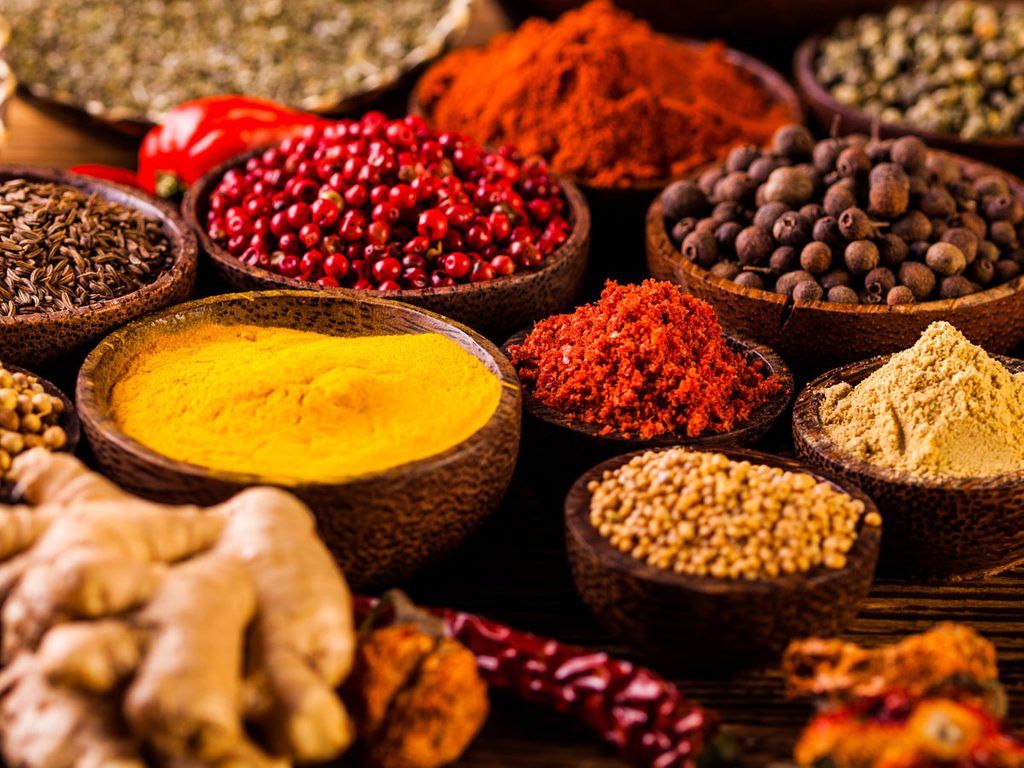To Shut Down Your Next Cold, Eat Some Southeast Asian Food

When you're feeling congested, a steaming hot bowl of Thai curry or some delicious Indian vindaloo might just help you breathe easier.
Chilis are one hot secret
Red chili peppers and green chili peppers are staples of Thai and Indian cuisines, and the spices convey many reported health benefits—such as adding years to your life. Well, now you can add helping to ease colds to the list. What makes these spices so special? Capsaicin. Research, including a review of studies published in 2015 in the journal Open Heart, suggests that the compound, which is found in hot peppers, has antiviral and anti-inflammatory properties. If you’ve ever taken a bite of a spicy dish, you’ve felt capsaicin in action. It can cause a runny nose and watery eyes—and that’s why it works. “These reactions will help release the locked mucus and open the nasal airways,” says David Greuner, MD, managing director and co-founder of NYC Surgical Associates in New York.
Garlic, ginger and more
Southeast Asian cuisine features other commonly used ingredients that also are believed to have decongestant and antioxidant powers. A review of studies, published in 2014 in Cochrane Database of Systematic Reviews, suggests that garlic may be helpful in preventing the common cold. Other research, including a review of studies published in 2019 in the journal Foods, shows that ginger—a staple in Thai and Indian dishes—has powerful antioxidant, anti-inflammatory, and antimicrobial properties.
Turmeric
One of the most common ingredients in Southeast Asian cuisine, turmeric, is a wonder drug in itself. When combined with ginger, it’s like a one-two punch to the common cold. “Both turmeric and ginger have been standard components of traditional Indian home remedies for colds and coughs,” says Anil Bathwal, executive chef and managing director of The Kati Roll Company in New York, New York. “The combination is meant to have synergistic anti-inflammatory, antioxidant, and antiseptic properties.” Keep in mind, this is how much turmeric you should have in a day.
How hot can you go?
So, when it comes to these beneficial spices, is there a limit to how much a person can take? “There is a measurement called the Scoville Scale, which measures the quantity of capsicum in a pepper—the more capsicum, the spicier the pepper is and the more irritated the mucous membranes will become if it is ingested,” says Rebecca Lewis, RD, head dietitian at the meal delivery service HelloFresh. One of the spiciest peppers is called bhut jolokia and comes from India. The jalapeño, a pepper most often used in Mexican foods, actually rates pretty low on the Scoville scale. Cayenne pepper falls somewhere in the middle. If you eat spicy food regularly, you can develop a tolerance to the peppers and they’ll no longer irritate your mucous membranes so much. In that case, says Lewis, only the spiciest of peppers with the highest capsicum quantities will cause your nose to run.
Go hot, not just spicy
Spicy foods that are prepared in warm broth are like a double whammy, as consuming warm liquids can help open and drain sinuses, ease breathing, expand the lungs, and relieve congestion, says Dr. Greuner. Spicy foods also increase body temperature and perspiration, which may help the body fight against viral and other infectious agents.
Simmering to salvation
Cooking down spicy foods like peppers, horseradish, cayenne, and crushed red pepper, into a sauce allows for a better release of the active ingredients than consuming the foods alone, providing improved immune system support, explains Lewis. Try your favourite curry recipe, or mix it with traditional chicken soup for extra cold-fighting power. (For another cold remedy, try this immune-boosting Fire Cider Brew.)
All chilis are not created equal
Southeast Asian cooking is not the only cuisine to employ chilis, so why is it so effective at fighting colds? “The difference between cuisines like Indian/Thai and Mexican food is that Indian/Thai actually have more of these main ingredients in raw form as opposed to being mixed with foods like rice and beans that cool down these strong flavours,” says Dr. Greuner. The more raw the ingredient, the more potent it will be in clearing your congestion.
Now that you know Southeast Asian food is an effective cold remedy, next find out how zinc can soothe your sniffles.




